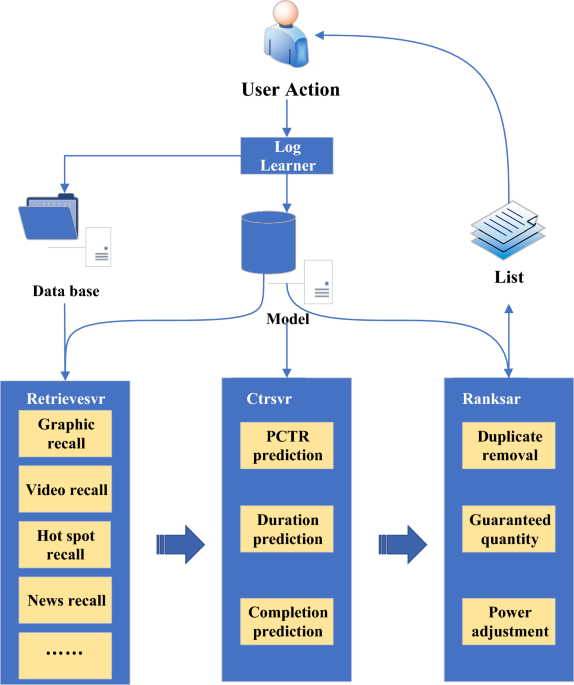Recommender system architecture
At present, the mainstream recommendation system architecture mainly includes four parts: the underlying basic data, the storage of data analysis, the recommendation calculation, and the business application25. In Fig. 1, Date-base is mainly used to store the underlying basic data and the profile and feature information obtained by analyzing the basic data and behavior logs. The recommendation calculation part mainly includes the recall and the ranking layer. The sorting layer can be further subdivided into a coarse and a fine sorting layer. The data obtained by means of hotspots, collaboration, and recall of portraits will first pass through the coarse sorting layer. After that, the fine ranking layer is further sorted by the click rate, duration, and completion degree prediction. Finally, the rule operations such as deduplication, quantity preservation, and weight adjustment are performed, and the recommendation result is obtained. Some models involved in the recommendation calculation are mainly obtained based on learning and training. Its offline training data can be extracted from the user’s behavior log. The recommendation results may be applied to different businesses. A new recommendation list is generated and recommended to users, as shown in Fig. 1.
Architecture of a recommender system.
In Fig. 1 above, in the recommendation algorithm designed in this paper, there are four key parts, each of which plays a specific role. The underlying basic data is the basis of the recommendation algorithm, including the historical behavior data of users and the attribute information of items. These data are used as the input of the algorithm to analyze user preferences and behavior patterns. The quality and diversity of the underlying basic data are very important for the accuracy and personalization of the recommendation algorithm. In the process of data analysis and storage, the underlying basic data is stored after processing and analysis to support the subsequent recommendation calculation. This includes the mining of user behavior and the analysis of item attributes. Storing the processed data is helpful to improve the efficiency and response speed of the algorithm and provide the necessary input for recommendation calculation. Recommendation calculation is the core of the whole algorithm, and the stored data is used for model training, feature extraction and other operations to generate the final recommendation result. This section may include various recommendation algorithms, such as collaborative filtering and deep learning model, to ensure accurate and personalized recommendation. The final output of the recommendation algorithm is applied to practical business scenarios, such as recommending goods to users on the e-commerce platform and recommending songs on the music platform. Business application is the interface between the whole recommendation system and users, and the quality and practicability of recommendation results have a direct impact on user experience and business effect.
RL
RL is a branch of Deep Learning (DL). The most prominent advantage of RL is the ability to learn from interactions26. In interacting with the environment, the agent continuously learns about the environment or completes certain tasks according to the reward or punishment obtained27. Usually, RL contains four elements: (A, S, R, and P). A represents all the actions of the agent; S represents the environmental states perceived by the intelligence; R represents the reward brought by the action, which is a value; P represents the strategy (or probability function). Its basic structure is shown in Fig. 2.
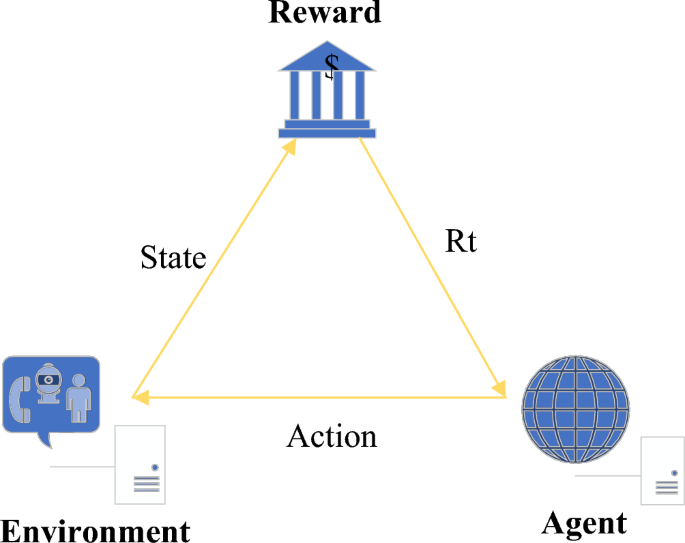
Q-Leaning is a common RL algorithm whose basic idea is Value-Based. Q(s,\(\alpha\)) means that the state at a certain moment is s(s ∈ S). The policy gradient algorithm that the agent can get by selecting action an (a ∈ A) is different from the Q-Leaning algorithm. Gradient policy algorithms set a value function and use an algorithmic policy (such as a greedy algorithm, etc.) to select a certain action. RL can be divided into two categories: model-free and model-based. A model is a simulation of a real environment. The main difference between Model-free and Model-based is whether the environment model is known or needs to be calculated. Model-free is further divided into policy gradient-based and value-based. Model-based allows the agent to simulate actions and states according to the model and plan the action path in advance. However, there is an error between the model and the real environment. This error can cause an agent to perform well on the model but not in a formal setting. The implementation and parameter tuning of the Model-free algorithm is more friendly, and this type of algorithm is more popular and has more applications. This study mainly discusses algorithms such as Model-free.
Deep RL
In this paper, RL algorithm is introduced to overcome the limitations of traditional recommendation algorithm in dealing with personalized recommendation. Compared with the traditional regression model, RL algorithm can better capture users’ dynamic interests and behavior patterns through interactive learning with the environment. This introduction is based on the pursuit of further optimization of the recommendation system. By emphasizing the ability to learn and adapt to the individual needs of users, the effect and adaptability of the recommendation algorithm are improved. In machine learning research, DL has strong perception ability but lacks judgment and decision-making ability. RL has better decision-making ability and lacks perception. Therefore, the combination of DL and RL provides solutions and methods for more complex problems requiring perception and decision-making28. RL is characterized by interaction. The goal is to achieve the maximum cumulative return. Any calculation process can increase the reward value of the agent in the interaction process. In the news communication recommendation system, the use of deep RL affects the next decision of the system in the news recommendation system and applies a scenario to an action. The system determines which operations can produce the most returns through users’ attempts. An action will affect the current immediate return and the next state. The subsequent return of the next state will be affected. Deep RL algorithms have been proposed for a long time, and researchers have also proposed many related algorithms. Deep Q-network (DQN) is a fusion of CNN and Q-Leaning. The advantage of this algorithm is that it can extract spatial information and learn appropriate control strategies from the original image data29. In the DQN algorithm, the calculation method of the objective function is shown in Eq. (1).
$${y}_{j}=\left\{\begin{array}{l}{R}_{j } \; is \;end=true\\ {R}_{j}+\gamma \,{\max}_ {\mathop \alpha \limits^{\prime}} Q\left(\varphi \left(\mathop {S_{j} } \limits{^{\prime}}\right), {\mathop {A_{j} }\limits}{^{\prime}}, w \right) \; is \; end=false\end{array}\right\}$$
(1)
In Eq. (1), the target Q value is calculated using the parameters of the currently trained Q network; φ and γ are the calculation parameters. However, practical applications prefer to update the parameters of the Q network based on \({y}_{j}\). \({A}_{j}\) represents the corresponding action of data element j. W represents the corresponding weight. DL and RL have very strong dependencies. In the iterative process, such a high correlation can easily cause the problem that the algorithm is not easy to converge. Meanwhile, the iterative process of DQN is shown in Eq. (2).
$$Q({S}_{t},{A}_{t})\leftarrow Q({S}_{t},{A}_{t})+\alpha \left[{R}_{t+1}+\gamma maxQ({S}_{t+1},\alpha )-Q({S}_{t},{A}_{t})\right]$$
(2)
There are two problems with such an iterative process. (1) The Q function puts the state \({S}_{t}\) and the action \({A}_{t}\) together for learning optimization, there is an action-independent deviation between different states. There are natural differences in the click-through rate of different recommended positions, and the relationship with the action is very small. (2) Max easily leads to the problem of overestimation, which makes the Q value of the model deviate greatly from the real value. The Q function is disassembled, as shown in Eq. (3).
$$Q\left({S}_{t},{A}_{t},\alpha ,\beta \right)=V({S}_{t},\alpha )+A({A}_{t},\beta )$$
(3)
\(\alpha \; {\text{and}} \; \beta\) are optimized states and actions. The Q function is a superposition of the state function V and the state-based action function A. Scholars proposed the Dueling DQN, whose structure is shown in Fig. 3. The main improvement of the neural network is that the Q value is obtained by adding the state and the action value A.
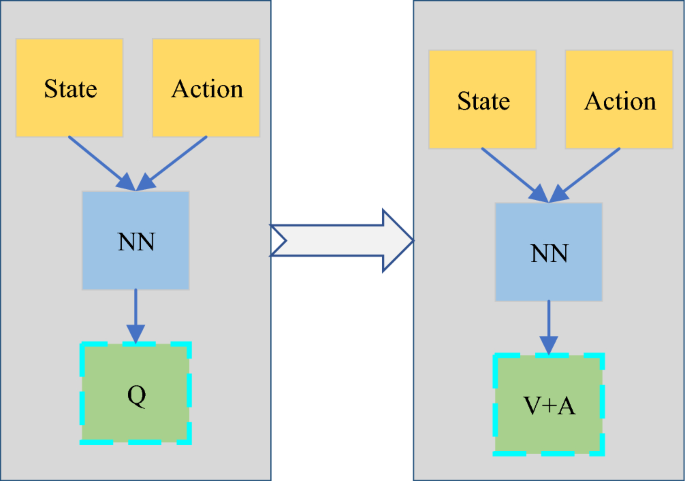
Evolution of DQN to Dueling DQN.
In Fig. 3 above, Dueling DQN (Deep Q-Network) structure is an innovative network architecture based on deep reinforcement learning (RL). Its core idea is to decompose the action value function into two parts: state value function and dominance function to estimate the value of each action more accurately. This structure consists of two independents fully connected neural networks, which are used to estimate the state value and dominance value respectively, and then calculate the final action value through a specific combination method. This decomposition enables Dueling DQN to learn the basic value of the state and the advantages of each action relative to the basic value more effectively, thus improving the accuracy of estimating the action value in complex environment. Decoupling the computation of the target Q value and the selection of actions is used to eliminate the overestimation problem, as shown in Eq. (4).
$$Q({S}_{t},{A}_{t})\leftarrow Q({S}_{t},{A}_{t})+\alpha \left[{R}_{t+1}+\gamma max \mathop Q\limits^{\prime} ({S}_{t+1},\alpha )-Q({S}_{t},{A}_{t})\right]$$
(4)
The schematic structure of Double DQN is shown in Fig. 4. Compared with the DQN algorithm, Double DQN is divided into two parts: the main network and the target network. The main network is responsible for selecting actions; the target network performs Q-value fitting.
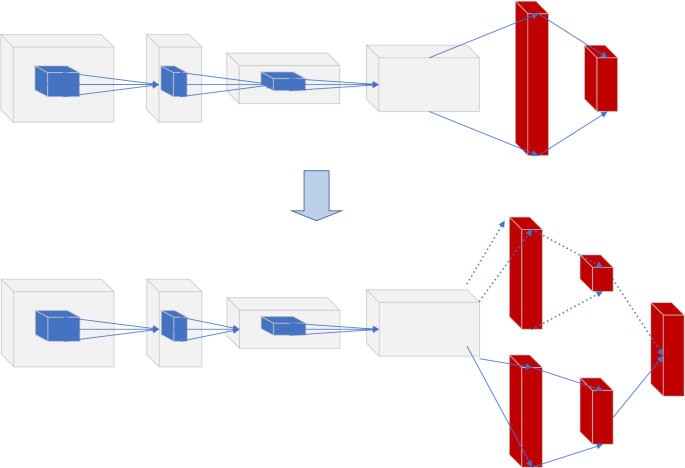
Evolution of DQN to dueling DQN.
The role of intelligent edge computing technology in news communication mode
The emergence of intelligent edge computing technology has constructed a new communication ecological model. The early digital transformation requires human resources to transform the data of the physical world into the digital world. As time goes by, digital transformation has gradually shifted from relying on human resources to AI30. Therefore, a new intelligent edge computing mode is proposed to enable each edge device of the Internet of Things (IoT) to have intelligent data collection, analysis and calculation, communication, and other capabilities. Edge architecture places data or applications at the edge of the network. Users can access data or applications at the network’s edge, reducing bandwidth load and resource waste. Edge mode can be used for any work31. For example, retailers can use edge infrastructure to process purchase transactions in local stores. This operation can prevent purchase problems caused by transmission delays. Enterprises can store in nearby data centers for faster recovery next time. Intelligent edge computing can simultaneously use the capabilities of cloud computing to configure, deploy and manage edge devices on a large scale. It can allocate device types and scenarios intelligently to achieve more intelligent flow between cloud and edge. Intelligent edge computing applications in small scenarios have low requirements for latency, Quality of Service (QoS), etc. However, in large-scale scenario applications, the requirements for real-time data throughput, reliability, connection distribution, etc., are high and need to be customized. Based on intelligent edge computing technology, enterprises can use edge devices’ computing and processing capabilities to directly handle most nearby IoT tasks. This can reduce the data center’s workload and more timely and accurately respond to the different states of edge devices, making edge devices truly intelligent.
The traditional mode of news communication is content production for a wide audience. Users can only find the content of interest in massive information. The emergence of intelligent edge computing technology has changed this situation. Data shows that among all business links of China’s news work, the application penetration of intelligent edge computing technology is most concentrated in public opinion monitoring, clue collection, accurate content dissemination, user portraits, etc. Intelligent edge computing technology Big data processing technology enables the audience’s information needs to be amplified and accurately calculated. This enables the accurate dissemination of massive amounts of information, meets the audience’s requirements in the digital age and improves the timeliness of news releases, personalized accuracy, and news production efficiency32,33. Most of the application operations of intelligent terminals provide the message push function, such as hot news recommendations of news clients, chat message reminders of interactive chat tools, e-commerce product promotion information, notification and approval process of enterprise applications, etc. Information push improves product activity, functional module utilization, user stickiness, and user retention. The news dissemination push algorithm is the key channel in the operation of news dissemination applications. The news dissemination push process based on intelligent edge computing technology is shown in Fig. 5.
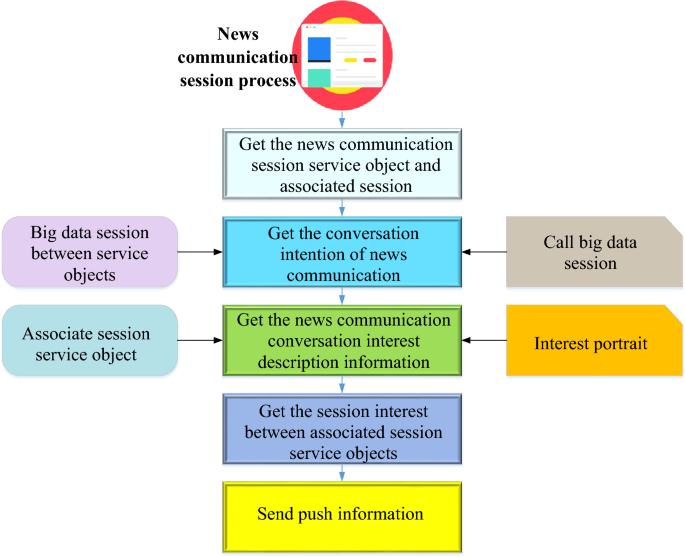
News dissemination push process based on intelligent edge computing technology.
In Fig. 5, the news dissemination push process and big data server are based on intelligent edge computing technology, and the target and associated intention lists corresponding to multiple targets and associated session nodes are used to construct the intention list of session nodes. The described information is obtained according to the intention list of the session node. In the target session subscription business segment of the big data session node sequence, the invoked target and associated session node are used. The session node interest sequence and information are constructed according to the flow direction of the calling business location and the session node interest sequence. The interest degree between the target and the associated session service object is obtained according to the session node’s intent and interest description information. The interest profile between the target and the associated session service object is determined. Then, the information display device corresponding to the target and associated session service object is sent the push information. The input information of session nodes, which is used to represent the intentionality interest degree of each session node, achieves the purpose of obtaining a more accurate interest portrait, improves the accuracy of interest portrait acquisition, and improves the service matching accuracy of news communication information push. In the whole process of news dissemination and push, intelligent edge computing technology intelligently constructs intention list and interest sequence, and combines with intelligent processing to obtain more accurate interest portraits, thus optimizing the service matching accuracy and precision of news dissemination and push mode.
Application of DDPG in news recommendation
The news dissemination push system needs to solve problems in the continuous action (state) space. DQN is used to deal with discrete action problems, while DDPG is extended to deal with continuous action problems. Based on generative adversarial learning, the advantages of the fusion Q and the policy networks are complementary: the DDPG. In DDPG, deep refers to the application of deep neural networks, and Deterministic Policy Gradient (DPG) is relative to stochastic policy gradients. In addition to continuous values, some sets of actions in RL may also be high-dimensional discrete values. In the case of a very large action space, if a random strategy is used to calculate the extreme value of all possible actions, a large enough sample size is required, bringing huge computational consumption. Therefore, some scholars propose the use of deterministic strategies. Under the same policy and state, the selected actions are based on probability distribution, and there is uncertainty for stochastic policies. Therefore, the stochastic probability gradient must be sampled in the entire action space. The gradient calculation based on the Q value is shown in Eq. (5):
$$\varepsilon J({\pi }_{\theta })={E}_{S-{\rho }^{\pi }},\alpha -{\pi }_{\theta } \left[{\text{log}}{\pi }_{\theta }(S,a)Q(S,a)\right]$$
(5)
In Eq. (5), \({\rho }^{\pi }\) is the state sampling space; \({\text{log}}{\pi }_{\theta }(S,a)Q(S,a)\) is the score function. The deterministic strategy is to select the action with the largest action probability. Under the same strategy and state, the action is uniquely determined, and the strategy becomes \({\pi }_{\theta }(S)=a\). The deterministic policy gradient is calculated based on the DPG gradient of the Q value, as shown in Eq. (6):
$$\varepsilon J({\pi }_{\theta })={E}_{S-{\rho }^{\pi }}, \left[{{\text{Q}}}^{\pi }(S,a){\pi }_{\theta }\right]$$
(6)
Compared with Eq. (5), DPG is less integral to action and more derivative of Q to action. The optimization process from DPG to DDPG is very similar to DQN to Double-DQN. However, DPG is an Actor-Critic structure. Therefore, the final DDPG has four networks: Critic-net, Critic-target-net, Actor-net, and Actor-Target-Net. Among them, the two Actor network structures are the same, and the two Critic network structures are the same. The overall structure of the model is shown in Fig. 6.
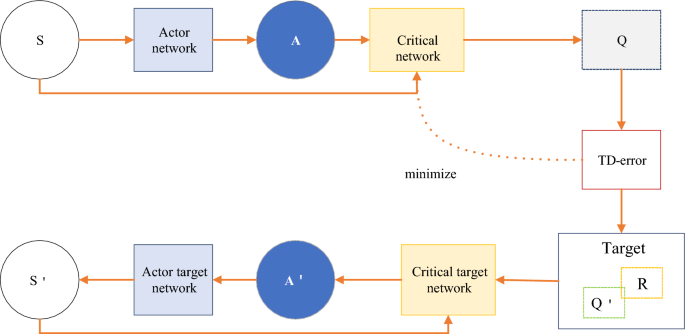
Overall structure of the DDPG network.
DDPG is a combined algorithm of DQN, Actor-Critic, and DPG methods. The four networks have corresponding functions, respectively. The Actor-Critic network is responsible for iteratively updating the policy network. According to the current state, S selects the current action A for interacting with the environment and generates S, R. The Actor-Target-Net is responsible for selecting the optimal next action A ́ based on experience replaying the next state S′ sampled in the pool. The network parameters O′ are periodically copied from O. Compared with the deterministic strategy, the main difference that the nondeterministic strategy may bring in this paper is the introduction of randomness, which makes the recommendation algorithm more exploratory in decision-making. By introducing randomness, the model has greater flexibility in exploring unknown fields and trying new recommendation strategies, which is helpful to discover potential high-quality recommendations. However, this paper also introduces some uncertainty, which may lead to the increase of the volatility of recommendation results and the decrease of the consistency of user experience. When solving problems, reasonable methods to reduce uncertainty can be successful in some application fields, especially in situations where users are more willing to accept recommended results with high consistency and stability, such as financial investment or medical and health fields. In these areas, users pay more attention to the credibility and risk control of recommendation, so it may be more popular to adopt a more deterministic recommendation strategy. However, in some fields that focus on innovation and diversity, such as entertainment and cultural recommendation, the introduction of uncertain strategies may be more in line with users’ expectations and provide a more surprising and diverse recommendation experience. Therefore, the successful application field depends largely on the user’s preference for consistency and exploration.
In the marginal environment, reinforcement learning can be used as a powerful tool to optimize the push mode of news dissemination. Edge computing involves processing distributed data and devices with limited resources, such as sensors, mobile devices or edge servers. Using reinforcement learning to optimize the news dissemination push mode can bring the following advantages: (1) Personalized push: Reinforcement learning can realize personalized news push by analyzing the data on the edge devices based on the user’s behavior and feedback. Therefore, the system can learn and adapt to users’ preferences, browsing history and interests, and provide news content that is more in line with users’ needs. (2) Resource optimization: In the marginal environment, reinforcement learning can help optimize the push algorithm and make it more efficient on devices with limited resources thereby reducing network traffic, saving energy and improving system response speed. (3) Decision-making: Reinforcement learning can make real-time decisions on edge devices without relying on centralized processing. By implementing intelligent agents on edge devices, the system can make real-time decisions according to local environment and user needs, and improve the news push effect.
Algorithm improvement and application
In applying a new communication recommendation system, the DDPG algorithm affects the user’s next reading behavior according to the user’s reading efficiency and time in a certain time interval. DDPN can help mobile news websites predict user needs more accurately and provide corresponding services. The diversity of news consumption is closely related to the interaction and integration of modern society. The analysis of the interweaving of users’ different news acquisition behaviors can help the experiment analyze their interests and complete the dissemination of high-quality content. When DDPG is applied to news recommendation scenarios, firstly, the corresponding content of the elements in RL should be clearly defined. The mapping is shown in Table 2.
The action representation of DDPG is continuous. In this scenario, the action is related to news and needs to be set as a continuous action. The solution taken is to design the action as an n-dimensional vector whose physical meaning is a piece of news. Additionally, the relevant news contains very rich features. If the relevant news feature embedding vector after embedding represents the action, the dimension may be too high. In order to reduce the dimension of this representative action, the experiment embeds different field features of relevant news and then performs a pooling operation. The recommended news list’s mutual order (sequence information) is imported into the RL model for training. Therefore, in order to utilize the sequence information between recommendation lists, CNN is used in the Deep part of DDPG, as shown in Fig. 7.
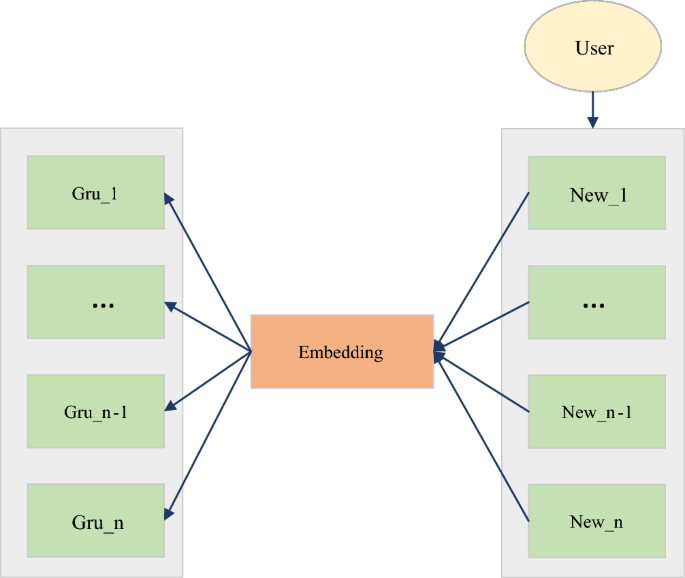
Information on GRU extraction sequences.
Figure 8 is a DDPG-type structure applied in news recommendations. Actor and Critic only draw one of the networks to make it easier to understand Actor-Critic. In this model, the parameters of the embedding layer are still shared, and a pooling operation is added. The information of the torrent news is added to the Context as part of the context. The solid line is the forward propagation, and the dashed line is the backpropagation of the gradient. The propagation of Policy Gradient spans Actor and Critic networks. In fact, the complete model diagram is relatively large and complex.
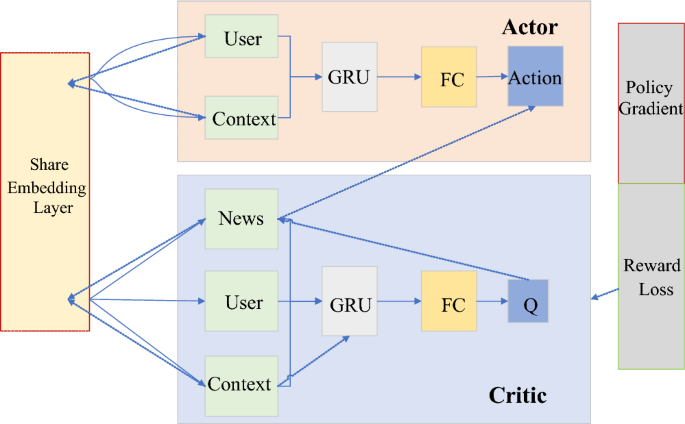
Schematic representation of the DDPG model.
Acquisition of experimental data
In the experiment, the batch size of the whole model is 16. The experimental operation platform is Intel Xeon@E5-2678, a v3 CPU computer. GTX2080TI’s graphics memory is 11G. Memory is 128G, AUC, MRR NDCG@5, and NDCG@10.
This study conducted experiments on two datasets: Outbrain and Real News. Outbrain (https://tianchi.aliyun.com/dataset/146367) is a public dataset. This dataset is the browsing and clicking behaviors of users on more than 560 websites on related news or advertisements recommended at the end of the website text, involving 2 billion browsing records, 87 million recommendation records, 16.9 million click behaviors, and corresponding textual and contextual information. Textual and contextual information includes publisher, publication time, topic, category, timestamp, platform, and more. Realnew (https://paperswithcode.com/dataset/realnews) is a large corpus of news articles from CommonCrawl. The data is crawled from CommonCrawl, which is limited to 5000 news fields of Google News Index. The author uses the NewspaperPython library to extract the text and metadata from each article. CommonCrawl dump news from December 2016 to March 2019 is used as training data; The article published in April 2019 came from the April 2019 dump for evaluation. After deduplication, RealNews is 120 GB. Statistics are shown in Table 3.
Offline evaluation index QAUC
The model evaluates its effect in a certain way. The evaluation of RL models is often performed using simulators. However, practice shows that there is a large bias in simulator evaluation. Therefore, combined with the characteristics of RL, an offline evaluation metric for RL models, QAUC, is proposed. The geometric meaning of QAUC is the area under the ROC curve. The area under the ROC curve is calculated, and the value of AUC is obtained. AUC’s probabilistic meaning is randomly selecting positive and negative samples. The probability that the predicted value of the classifier for positive samples is greater than that for negative samples, as shown in Eq. (7).
$$AUC=P({P}_{+}>{P}_{-})$$
(7)
The labels P of positive and negative samples are two values of 1.0, as shown in Eq. (8).
$$AUC=P\left({P}_{i}>{P}_{j}|{L}_{i}>{L}_{j}\right)$$
(8)
A model with a better binary classification effect has a greater probability that the positive samples’ predicted value is greater than the negative samples’ predicted value. The AUC value is larger. On the deep RL model, the predicted Q value of the large sample is also larger, and the model effect is also better. However, AUC can only be used for binary classifiers whose label values are 0,1 integers. The r and Q values of the deep reinforcement model are both floating point and indeterminate quantities. AUC cannot be directly used in this scenario’s model evaluation of RL. QAUC is proposed to solve and reduce the computational complexity of the model.
The probabilistic definition of traditional AUC and the application scenario of QAUC are shown in Eq. (9).
$$QAUC=P\left({Q}_{i}>{Q}_{j}|{r}_{i}>{r}_{j}\right)$$
(9)
By comparing two randomly selected samples I and J, firstly, on the premise that the actual reward of sample I is greater than that of sample J, the probability that the predicted value of sample I is greater than that of sample J is calculated and recorded, and the sorted samples are read one by one according to this probability. In the traversal process, if the actual reward value of the current sample is equal to the previous sample, update A [g]. If the actual reward values are not equal, the R of the current sample pair quantity N will be updated, and the relative quantity Q will be calculated. Finally, the conclusion of QAUC will be drawn based on these calculation results, which reflects the accuracy and performance of the model in ranking the predicted values in the samples with orderly actual returns. The loop iterates, and finally, QAUC = Q/R is obtained.
In Fig. 9, QAUC draws on the probability idea of AUC and is compatible with AUC. Therefore, QAUC applies to all scenarios of AUC. This study uses QAUC in RL-based news recommendation scenarios. It can also be applied to other similar RL offline evaluations.
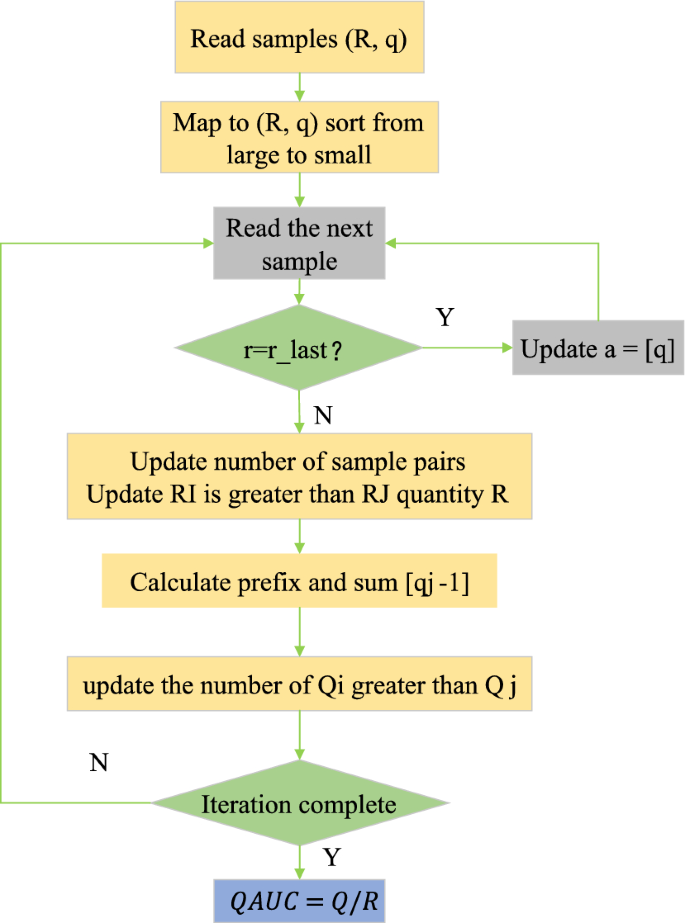
Calculation flow of QAUC.

Wanda Parisien is a computing expert who navigates the vast landscape of hardware and software. With a focus on computer technology, software development, and industry trends, Wanda delivers informative content, tutorials, and analyses to keep readers updated on the latest in the world of computing.

